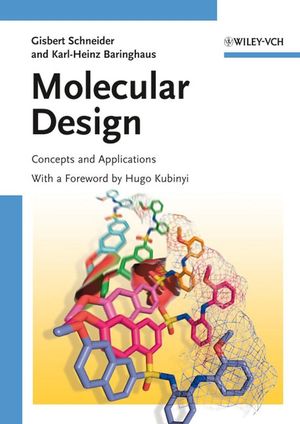Molecular Design: Concepts and ApplicationsISBN: 978-3-527-31432-4
Paperback
277 pages
February 2008
 |
||||||
Molecular Objects and Design Objectives
- Molecular geometry and surface
- Molecular properties
- The concept of drug-likeness
- Representing molecules as strings
Receptor-Ligand Interaction
- Thermodynamics of protein-ligand interaction
- QSAR: estimating quantitative structure-activity relationships
- The biophore concept
- Pharmacophores
Creating the Design
- Rational drug design
- Ligand-based design of compound libraries
- Transition state analogs
- de novo design
Virtual Screening
- Similarity searching
- Pharmacophore-based virtual screening
- Molecular docking and scoring
- Structure-based vs. ligand-based design
- Case study 1: design of Kv1.5 ion channel modulators
- Case study 2: virtual screening of a natural-product derived combinatorial library for novel 5-lipoxygenase inhibitors
- Case study 3: scaffold de novo design for cannabinoid-1 (CB-1) receptor ligands
Secondary design constraints and machine learning
- Introduction to Pharmacokinetics
- Prodrugs and bioisosters
- Machine learning methods
- Case study 1: predicting cross-activities of allosteric modulators of metabotropic glutamate receptors (mGluR)
- Case study 2: dopamine D3 antagonists and ACE inhbitors
- Molecular geometry and surface
- Molecular properties
- The concept of drug-likeness
- Representing molecules as strings
Receptor-Ligand Interaction
- Thermodynamics of protein-ligand interaction
- QSAR: estimating quantitative structure-activity relationships
- The biophore concept
- Pharmacophores
Creating the Design
- Rational drug design
- Ligand-based design of compound libraries
- Transition state analogs
- de novo design
Virtual Screening
- Similarity searching
- Pharmacophore-based virtual screening
- Molecular docking and scoring
- Structure-based vs. ligand-based design
- Case study 1: design of Kv1.5 ion channel modulators
- Case study 2: virtual screening of a natural-product derived combinatorial library for novel 5-lipoxygenase inhibitors
- Case study 3: scaffold de novo design for cannabinoid-1 (CB-1) receptor ligands
Secondary design constraints and machine learning
- Introduction to Pharmacokinetics
- Prodrugs and bioisosters
- Machine learning methods
- Case study 1: predicting cross-activities of allosteric modulators of metabotropic glutamate receptors (mGluR)
- Case study 2: dopamine D3 antagonists and ACE inhbitors



